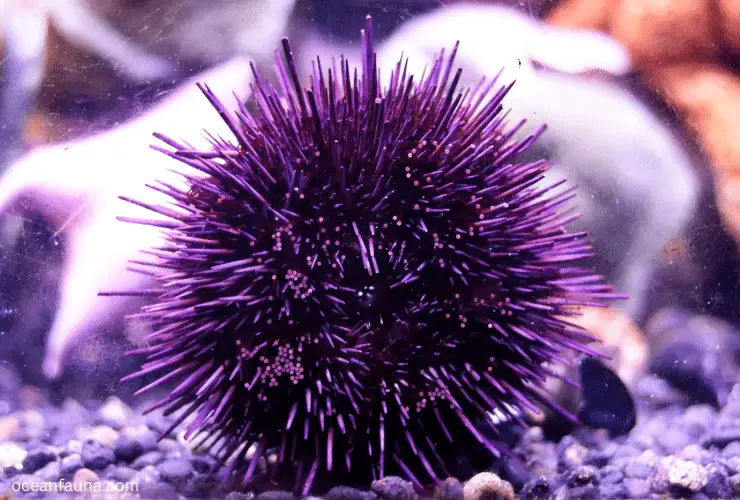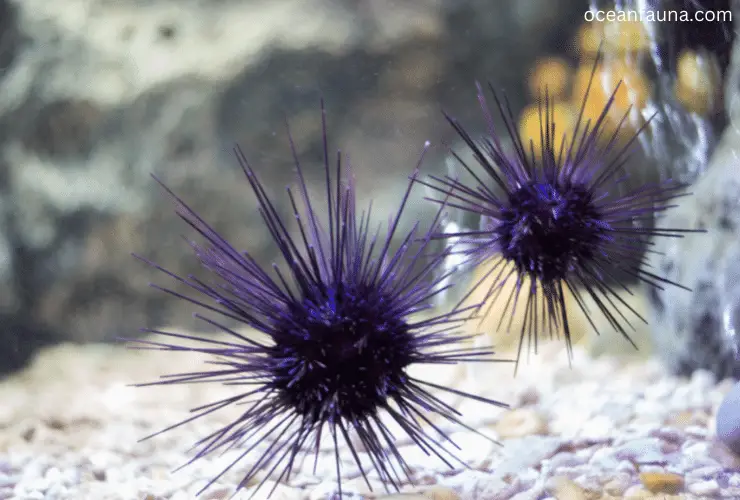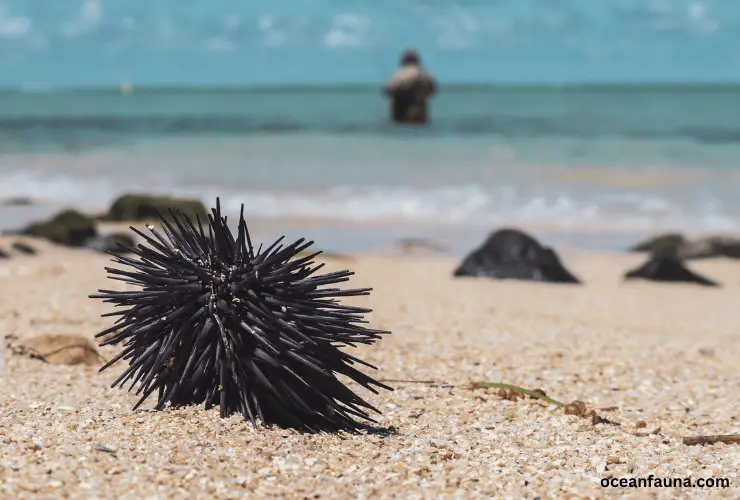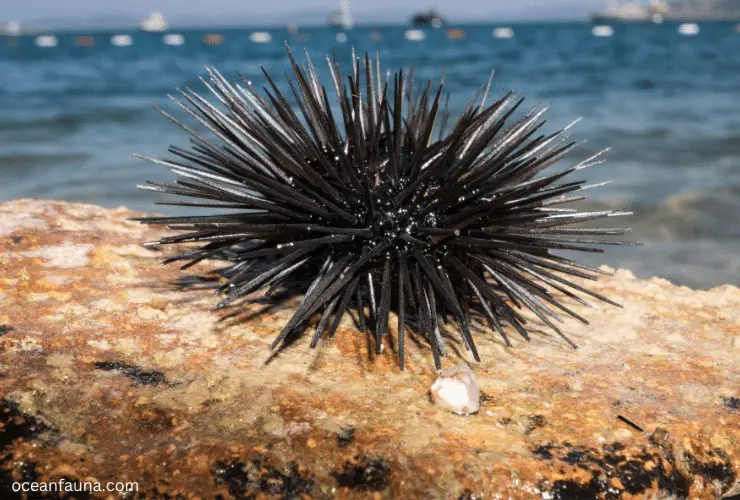Sea urchins are invasive. It can be proved by the size of their population and the barren areas they created due to the overgrazing of kelp beds. This can be devastating for the ecosystems. However, some measures and solutions can be taken to slow down their population growth.
In places known as urchin barrens, sea urchins have totally displaced the once-abundant kelp. Now, the healthy amount of 2 urchins per square meter has been replaced by 70 individuals in the same space. The seafloor is covered with what has been called a “purple carpet” of spiked bodies.
In this article, we have decided to talk about these invasive species. We will also discuss the recent destruction by urchins on sea floors and forests. The remedies for handling these marine animals will also be unwrapped here. Let’s read on to get insights.
Are Sea Urchins Invasive Species?
There is no doubt that sea urchins are invasive species. According to the World Economic Forum, the urchins have become so destructive to our seabeds that they are considered the biggest challenge to the ecosystems of the world. (Source)
The urchins have displaced the once-abundant kelp beds that were vital to marine ecosystems. Today, there are some places on the California and Oregon coasts where you can hardly see any kelp.
Scuba.com’s researchers have also verified this fact:
“What do green crabs, sea urchins, and lionfish all have in common? They’re all considered invasive species because of the negative effects they have on local marine ecosystems.” (Source)
These angry-birds-like creatures are notoriously aggressive. They do not hesitate to dive deep to attack and eat any living organisms like mollusks, marine worms, and algae. They usually feed on primary producers.
According to another research by the NPR organization, these zombie urchins are killing kelp forests in Northern California.
“Off the coast of California, purple sea urchins have proliferated to cover the ocean floor. And they eat kelp, so the seaweed forests that used to border the shoreline are dwindling. Most bull kelp and over 95% of all kelp in a vast section of Northern California have disappeared since 2014.” (Source)
OPB organization has also talked about these underwater zombies:
“The West Coast environment is under siege from hundreds of millions of mindless purple sea monsters. The number of these purple sea urchins has increased by a factor of 10,000 in the past several years, and they are now a major threat to kelp forests. Not only that, but they taste great.” (Source)
The main query here is: Why are they invasive?
There are many reasons. Among them is the importance of their home ranges for the reproduction of their urchin hosts. They are thirsty and hungry for eating living creatures.
However, these animals also suffer from nutritional deficiencies in their marine environment. They have little time to eat the algae because of the predation by the sea lion.
Though sea urchins feed on kelp, they are less tolerant of it than the species that have their natural diets. Hence, the kelp-eating urchins can destroy the seabed and forest. The sea lions have a tasty meal, too.
The rocky outcrops and corals of this coast are to blame for the destructive and uncontrolled growth of urchins. In other areas, a spike in their population has replaced forests that are considered to be the most vital and majestic of all species that belong to the ecosystem.
How Long Do Sea Urchins Live?
Research given at the Aquarium of the Pacific clearly answered the life span of sea urchins.
The researchers’ state:
“The lifespan of red sea urchins was once thought to be between 7 and 10 years. Recent research has found that the average lifespan varies greatly from region to region.
Compared to their northern counterparts, red sea urchins in British Columbia, Canada, can live well over a century old.
Canadian urchins larger than 19 centimeters (7.5 inches) in diameter were estimated to be around 200 years old in the same investigations.” (Source)
Thus, sea urchins can live a life from 7 to 200 years, depending on the situation and other factors. There is no set captive lifespan for these animals.
They can survive a few years or hundreds of years. There is no exact number that defines their lifespan. However, they reach their maturity level at three to five years old.
Are Sea Urchins Protected?
Yeah, sea urchins are always protected. They protect themselves with their sharp and strong spines. These spines are sharp and look like the quills of a hedgehog. This helps them to be safe from most predators.
Most of the urchins’ spines are venomous, which helps them to survive in hazardous situations. But think about humans. What if predators for urchins are humans? How to protect them from food lovers?

Many countries have restricted the hunting and eating of sea urchins. According to DPI news:
“Commercial sea urchin fishing occurs in the Australian states of New South Wales, Victoria, Tasmania, and South Australia. Commercial turban shell harvesting is primarily limited to the waters of New South Wales.
Few divers take part in the small NSW Sea Urchin and Turban Shell (SUTS) restricted fishery. High processing costs and a lack of domestic markets are currently the biggest obstacles to growth in New South Wales.” (Source)
Why Are Sea Urchin Populations Rising?
There could be many reasons behind the rising populations of sea urchins. Scientists believe climate change is the major reason behind the overpopulation of these animals.
For example, starfish (the main predator of urchins) in the Pacific Ocean died due to disease caused by warm water. This unbalanced situation causes urchins spread unchecked.
More urchins finish the kelp forests and negatively affects the ecosystems. This is one of the main reasons behind the rising strength of these sea creatures.
Another big reason behind sea urchins carpeting on seabeds is their reproduction rate. Although the larvae survive less and their chances of reproduction are low, still they spread millions of eggs and sperm in the water.
What if survival is only 2%? Still, it’s a big number. Thus, the reproduction rate is highly dependent on the expansion population of sea urchins along with rising sea temperatures.
What is the Purpose of Sea Urchins?
These annoying organisms are very important for a solid and effective environment. There is a purpose behind everything and every living creature in this world has a purpose in life. They have an impact on nature.
However, these pesky creatures play a crucial role in the health of coral reef ecosystems, so we should be thankful for them despite their annoyance. But we didn’t mean overpopulation of anything is beneficial.
When you consider how many various kinds of fish and invertebrates call coral reefs home, the contribution of the long-spined black sea urchin to graze 45% of the food (mostly algae) on coral reefs becomes clear.
Herbivorous fishes appeared to be ecstatic as soon as they realized there was 45% more food available to them after the urchin die-off. As a result of the food boom, reproduction rates in some species spiked, which is more dangerous for sea life.
An increase in algal cover of this magnitude demonstrates that Diadema antillarum is an important keystone herbivore for Western Atlantic coral reefs. Sea urchins play a vital role here and equalize the sea ecosystem.
Are Sea Urchins A Problem? Why Are Sea Urchins Harmful?
Sea urchins are only a problem once they are overpopulated and overpower the living standards of other living organisms in the sea. Urchins deplete the ocean floor’s kelp forests, which sequester carbon dioxide and serve as a food and habitat source for a wide variety of marine organisms.
Sydney Fish Market has curiously given a solution to this problem. Let’s see what’s that:
“Recently, OceanWatch and the NSW Abalone Association launched a program to reduce the number of urchins and improve the reef in areas where barrens have developed. The urchin population in four urchin barrens (totaling 8 hectares) off the coast of New South Wales has been steadily reduced in recent years.
Thanks to the efforts of divers employed by the abalone, sea urchin, and turban shellfisheries. Not only did we want to boost the quality of the surviving urchin roe and the amount of excellent Abalone with this effort, but we also wanted to improve seaweed habitats and so promote biodiversity.” (Source)
These free-living organisms are not just beneficial for the marine ecosystems but also harmful if overpopulated. So, the solution here is to stop the population of sea urchins at least till their population ratio becomes balanced again.
Are Sea Urchins Destructive?
Yes, sea urchins are destructive. But several types of sea urchins are not good for the reefs and plankton because they consume the plankton faster than they can reproduce. They also have sharp edges and thus can easily cut the coral and cause damage to it.
Just to make things clear, sea urchins have the potential to be really dangerous for the oceans and beaches. They could wreak havoc in the ecosystems of coral reefs. At its worst, there are urchins scattered all about.

Mae Rennik, a Ph.D. candidate in ecology and evolutionary marine biology at the University of California, Santa Barbara, explains, “They’re practically stacked on top of each other scrambling for room.” Such changes “may occur rapidly.” (Source)
It’s better to leave sea urchins to their own natural lives because all these creatures are the ecosystem custodians or to eat them to stop rising populations. The main focus is the survival and well-being of the ecosystem.
Anticipating this, many countries have already set up laws that prevent and restrict sea urchins’ harvest. These laws are also enough to control this very important part of the ecosystems in the areas where sea urchins coexist with the organisms that make the reef possible.
Are Sea Urchins Bad for The Environment?
Usually, sea urchins are not bad for the environment. They are bad, even worst, if their population is uncontrollable. More interestingly, these are called “cockroaches of the ocean“, according to an article in New York Times.
Christie Yorke, a postdoctoral scholar at the Marine Science Institute at the University of California, Santa Barbara, explains that urchins can disproportionately impact kelp forests when their natural predators are absent. (Source)
Why Are We Removing Sea Urchins? What Happens If You Remove Sea Urchins?
According to an explanation given by Frontiers In, “The eradication of sea urchins is a straightforward, low-cost, and effective strategy for facilitating the recovery of kelp in urchin barrens.” (Source)
If you remove sea urchins completely, the ecosystem will be affected. If your intent in removing the urchins is to balance the reefs and corals, this will help the marine life flourish equally.
Are All Sea Urchins Dangerous?
All sea urchins are not dangerous. Only a few species are toxic. The long-spined sea urchin or wana in Hawaiian, is the most dangerous in the world.

This is one of the venomous species and can cause a painful sting if injected. It’s good to stay away from these urchins. They can sting or bite you and can cause serious health issues.
FAQs
Are sea urchins invasive in Hawaii?
Sea urchins are not invasive in Hawaii. It’s the seaweed that’s invasive there. They act as a weapon in the fight against invasive alien seaweeds in Hawaii.
They eat seaweed to stop the growth rate of these harmful algae. They keep them controlled so that the kelp and coral can thrive.
Are sea urchins invasive in Florida?
They are not invasive in Florida. However, the Atlantic Ocean, Florida Bay, and the Gulf of Mexico are all suitable habitats for sea urchins found along Florida’s coastline.
Without permission from FWC, it is prohibited to harvest urchins from public lands in Florida or to take them by boat in waters governed by FWC. The long-spined sea urchins are extinguishing in Florida.
Are sea urchins invasive in New Zealand?
Sea urchins are invasive in New Zealand; especially the native Kina is in a boom. After urchins’ graze on the seaweed and kelp, what’s left is a barren or low-productivity reef, creating what’s known as a kina barren.
Its population was once kept in check by predators, but today, with overfishing, rising water temperatures, and human activities, it is booming. Several measures were taken to control this invasive species.
Are sea urchins invasive in Greece?
Sea urchins are invasive in Greece. Scientists report seeing a poisonous sea urchin in the waters around at least 12 Greek islands due to global warming.
What country eats the most sea urchin?
Japan, France, and Korea consume the most sea urchin. However, Japan wins here. They consume 80 to 90 percent of the current worldwide supply. It’s used as a traditional food in Japan. They love to eat sea urchins.
Conclusion
Sea urchins are those sea creatures that are a blessing to our ecosystems and harmful if invasive. They are unpredictable. Their population growth sometimes declines and sometimes rises. Sea urchins are very important for the planet and if not managed properly, then they can cause a huge bustle in the ecosystem. But if you remove them, you may be harming other organisms. It’s important to understand the ecological balance.


Awesomе article.